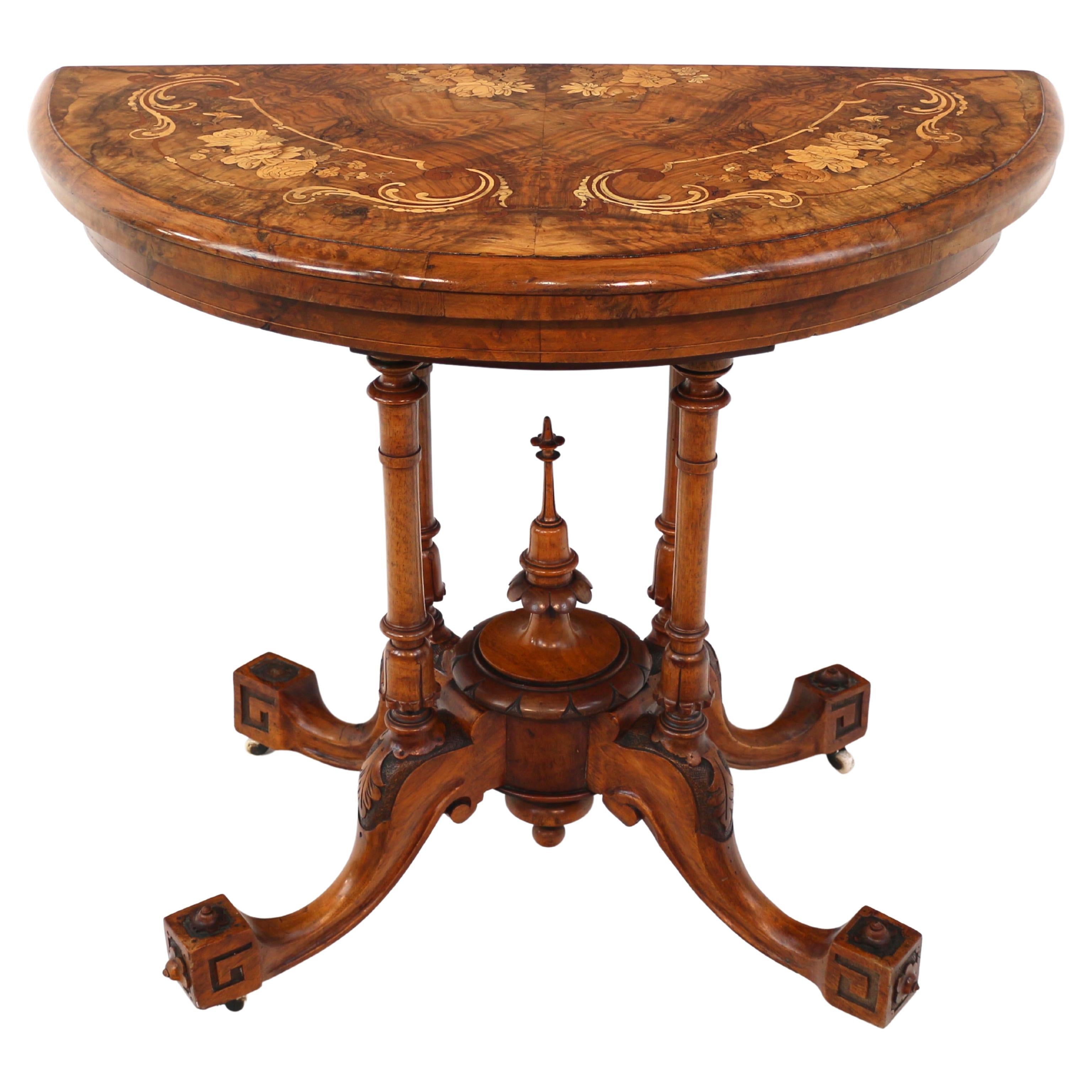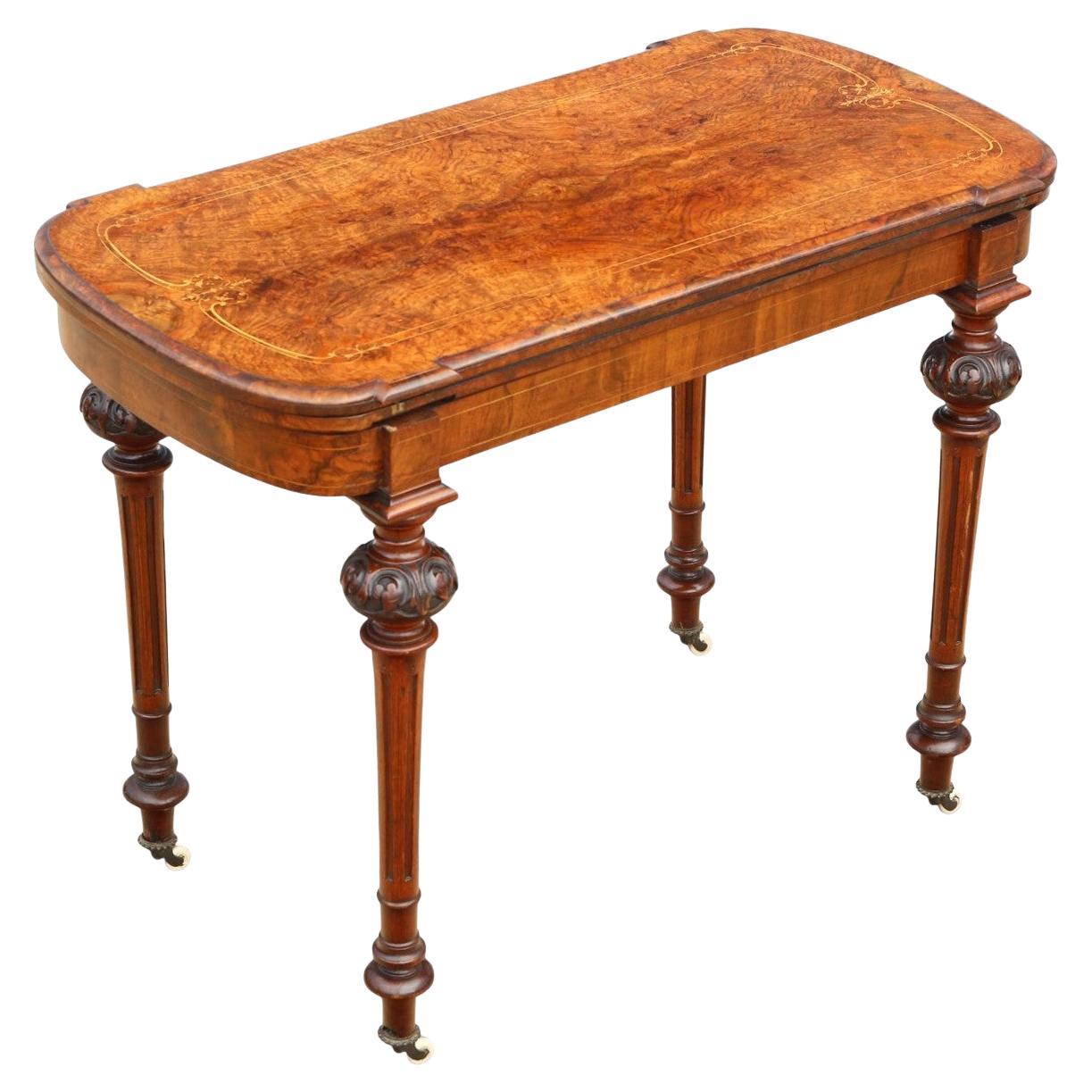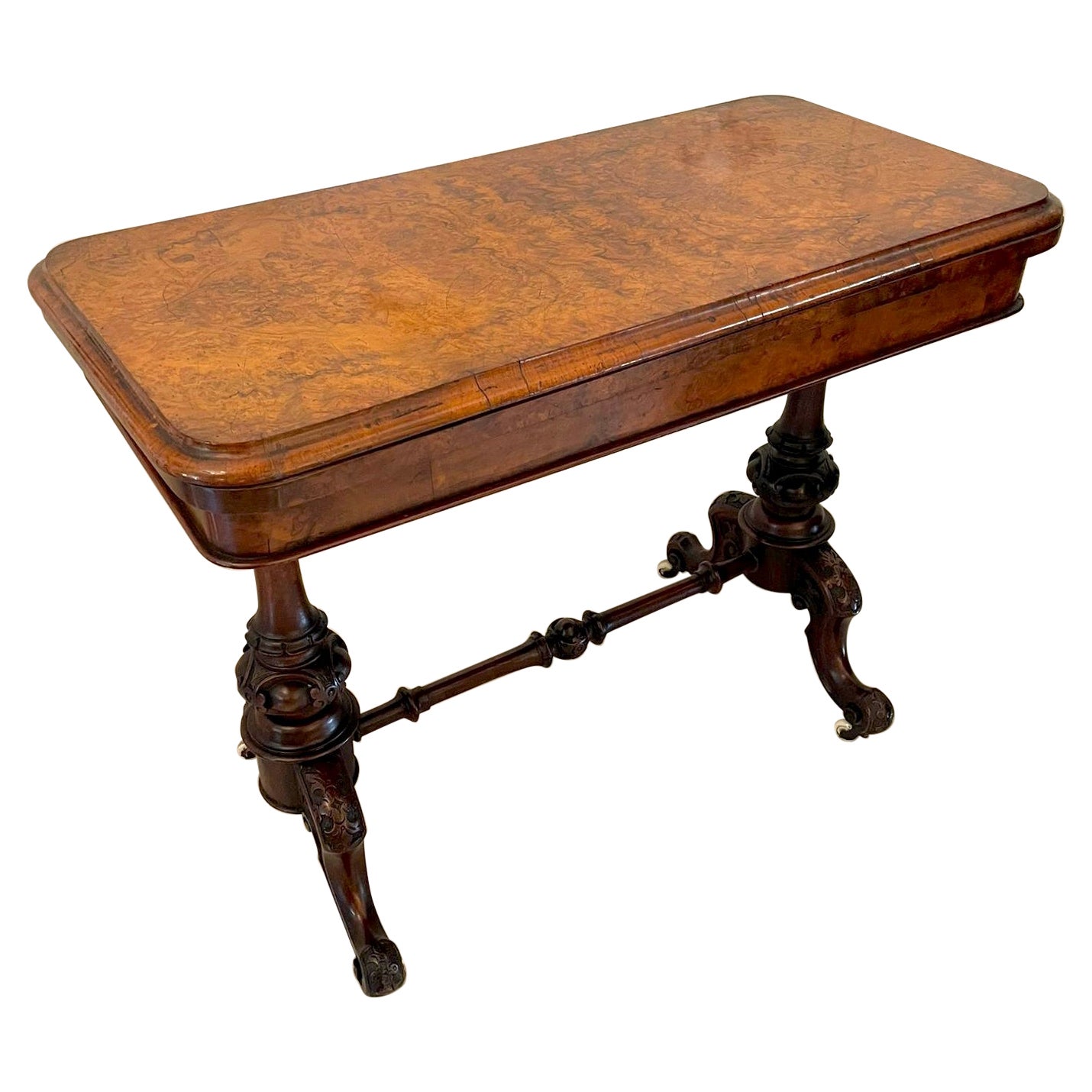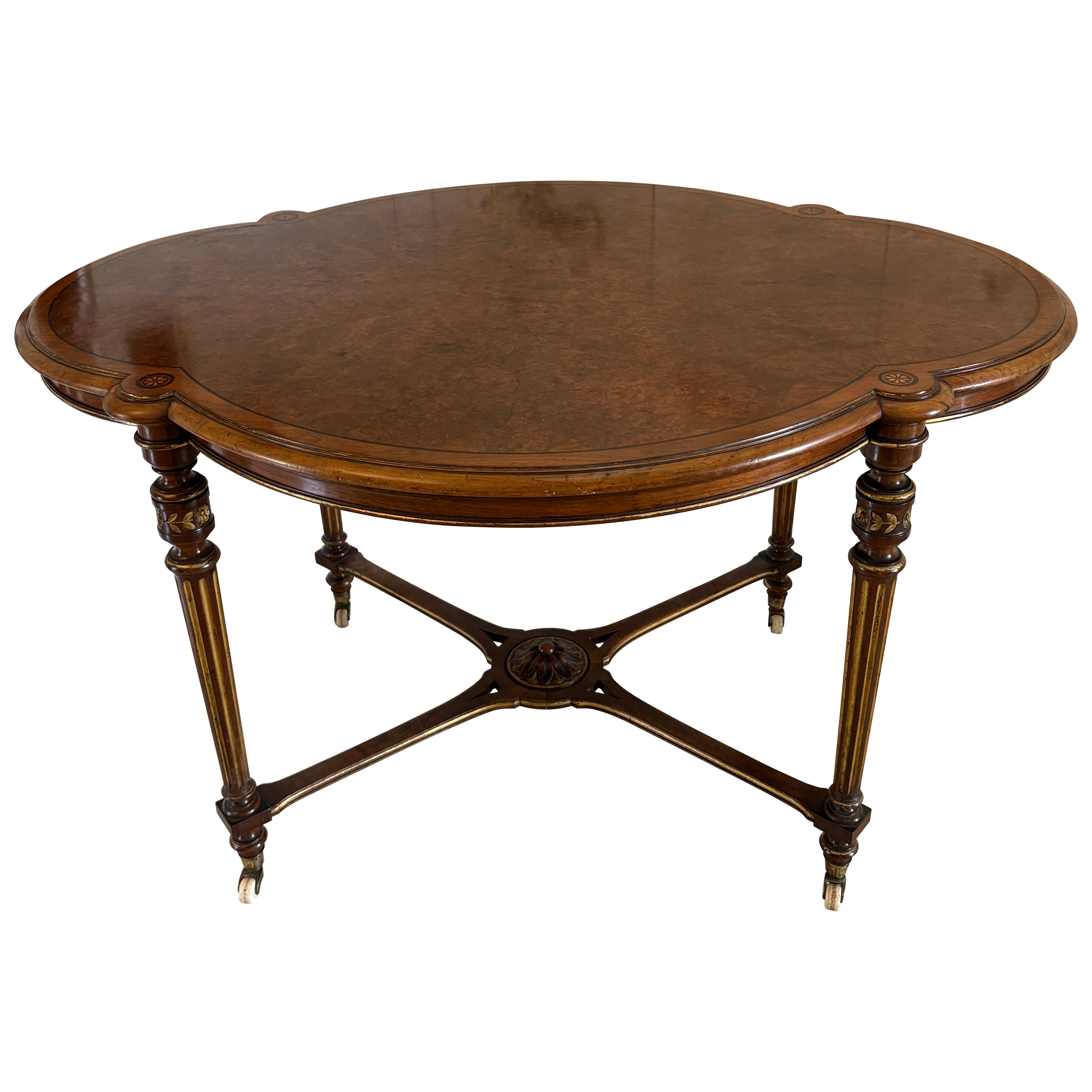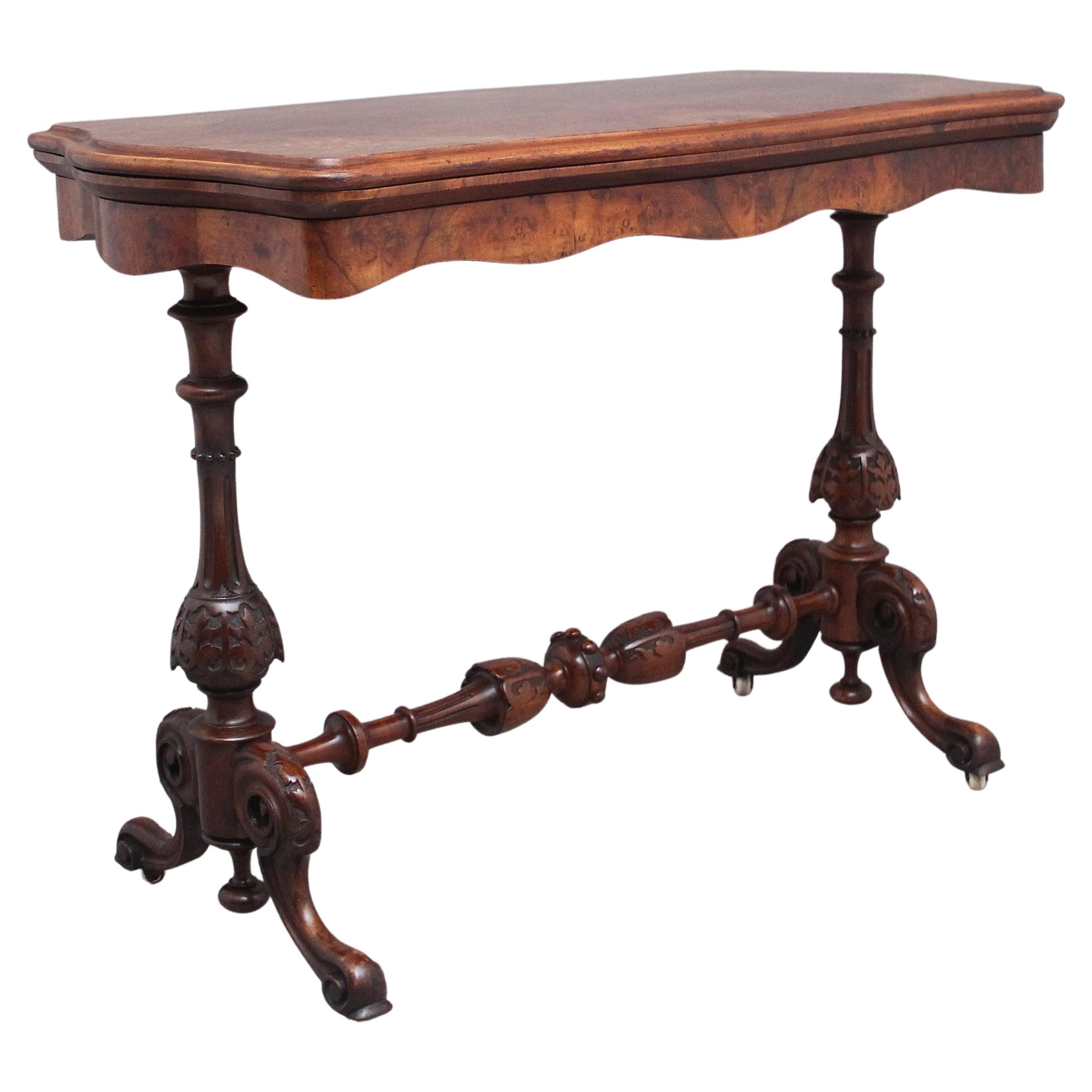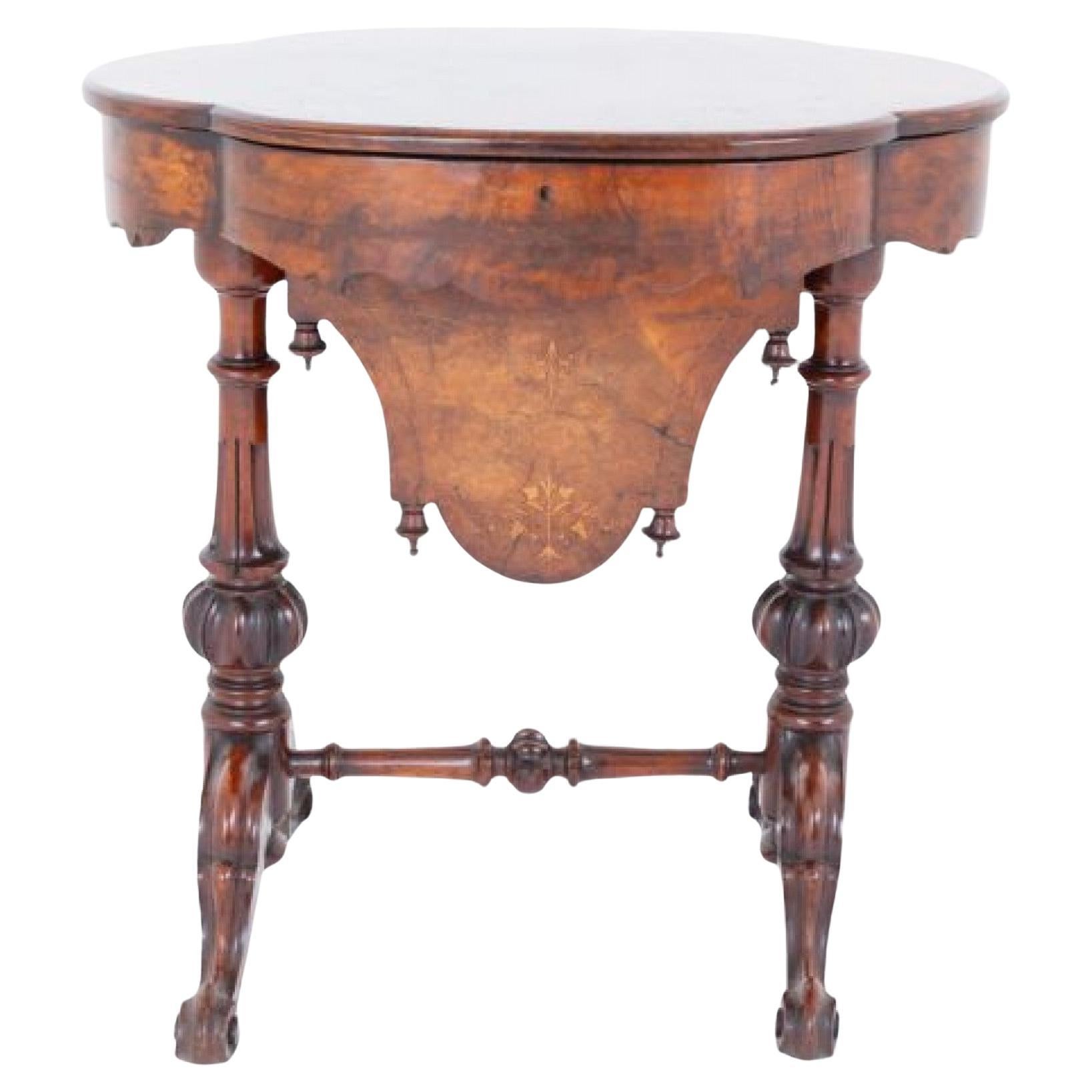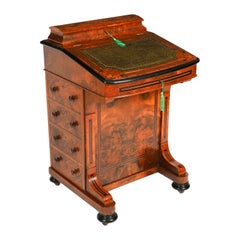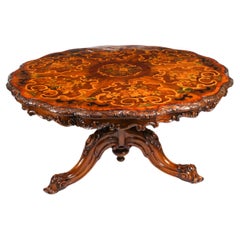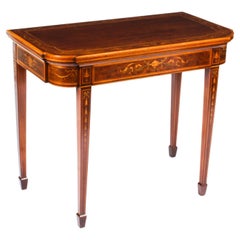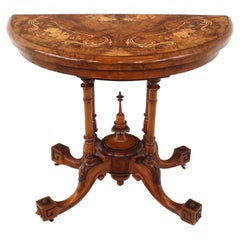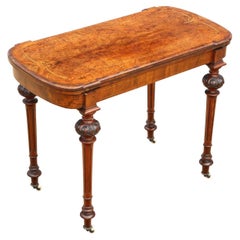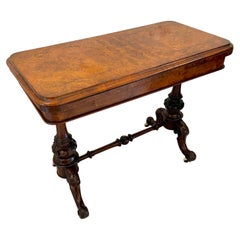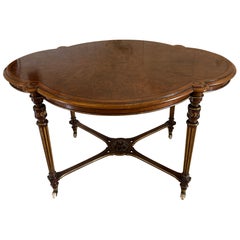Items Similar to Antique Victorian Burr Walnut and Inlaid Card Table C.1860 19th Century
Want more images or videos?
Request additional images or videos from the seller
1 of 17
Antique Victorian Burr Walnut and Inlaid Card Table C.1860 19th Century
$1,981.79
£1,450
€1,704.92
CA$2,766.98
A$3,017.87
CHF 1,586.67
MX$36,506.23
NOK 19,799.67
SEK 18,708.81
DKK 12,728.50
About the Item
A rare and attractive English antique Victorian half moon card table in burr walnut with superb inlaid decoration and green baize playing surface, Circa 1860 in date.
This card table features superb hand-carving to the solid walnut base and the attention to detail on this piece is second to none!
There is no mistaking its unique quality and design, which is certain to make it a talking point in your home. As such, this card table is sure to take pride of place in your home.
Condition:
In really excellent condition having been beautifully cleaned, polished and waxed in our workshops, please see photos for confirmation.
Dimensions in cm:
Height 70 cm x Width 90 cm x Depth 45 cm - Closed
Height 69 cm x Width 90 cm x Depth 90 cm - Open
Dimensions in inches:
Height 2 foot, 4 inches x Width 2 foot, 11 inches x Depth 1 foot, 6 inches - Closed
Height 2 foot, 3 inches x Width 2 foot, 11 inches x Depth 2 foot, 11 inches - Open
Burr Walnut refers to the swirling figure present in nearly all walnut when cut and polished, and especially in the wood taken from the base of the tree where it joins the roots. However the true burr is a rare growth on the tree where hundreds of tiny branches have started to grow. Burr walnut produce some of the most complex and beautiful figuring you can find.
Victorian Furniture (1830-1901) is popular today, probably due to its accessibility more than the esthetics. There was plenty of furniture made due to the change in history of methods of manufacture, the machine had taken over and was able to produce mass amounts of Victorian furniture to satisfy the vast demand by the middle class people that desired it.
Furniture history changed forever through the Victorian period. It became desirable to have a home laden with furniture to show your status to your peers.
Throughout history Queen Victoria identified herself with the middle class. Therefore the furniture of this period was made for an ever-increasing middle class population. The most popular woods used to produce furniture included: mahogany, burr walnut, rosewood and ebony. Thick, darkly coloured woods with ornate carvings, high-tone gloss, richly carved silhouettes and as many flourishes and ornaments as the surface of a piece of furniture would allow were typical for this period. They were designed to give the appearance of being owned by the wealthy.
Mahogany and rosewood were popular and rich colours, intensified by layering high-gloss lacquers over stained wood were highly desired. Comfort was an important consideration for purchasers who wanted their homes to be gracious reflections of their financial, so velvet cushions and brocade sofa fabric were often coordinated with velvet drapes for maximum impact.
Our reference: A4607
- Dimensions:Height: 27.56 in (70 cm)Width: 35.44 in (90 cm)Depth: 17.72 in (45 cm)
- Style:Victorian (Of the Period)
- Materials and Techniques:
- Place of Origin:
- Period:
- Date of Manufacture:circa 1860
- Condition:
- Seller Location:London, GB
- Reference Number:Seller: A46071stDibs: LU950646268122
About the Seller
5.0
Platinum Seller
Premium sellers with a 4.7+ rating and 24-hour response times
Established in 1983
1stDibs seller since 2012
1,405 sales on 1stDibs
Typical response time: <1 hour
Associations
LAPADA - The Association of Arts & Antiques Dealers
- ShippingRetrieving quote...Shipping from: London, United Kingdom
- Return Policy
Authenticity Guarantee
In the unlikely event there’s an issue with an item’s authenticity, contact us within 1 year for a full refund. DetailsMoney-Back Guarantee
If your item is not as described, is damaged in transit, or does not arrive, contact us within 7 days for a full refund. Details24-Hour Cancellation
You have a 24-hour grace period in which to reconsider your purchase, with no questions asked.Vetted Professional Sellers
Our world-class sellers must adhere to strict standards for service and quality, maintaining the integrity of our listings.Price-Match Guarantee
If you find that a seller listed the same item for a lower price elsewhere, we’ll match it.Trusted Global Delivery
Our best-in-class carrier network provides specialized shipping options worldwide, including custom delivery.More From This Seller
View AllAntique Victorian Burr Walnut & Inlaid Davenport Desk 19th Century
Located in London, GB
This is a gorgeous antique Davenport desk which is crafted from beautiful burr walnut, circa 1870 in date.
The desk has a rear stationery compartment which encloses a divided interi...
Category
Antique 1870s Victorian Desks and Writing Tables
Materials
Walnut
Antique 4ft 6" diam Burr Walnut Marquetry Dining / Center Table 1860s
Located in London, GB
This is a fine and rare antique English mid Victorian, burr walnut, ebonised and fruitwood marquetry, centre table, in the manner of Edward Holmes Baldock and circa 1860 in date.
The shaped segmentally veneered circular top is beautifully marquetry inlaid with assorted flowers within shaped cartouches and features a beautiful scrolled foliate carved edge.
It sits on a cabochon and acanthus-wrapped baluster column with three cabochon-embedded, foliate-scrolled, rocaille-carved outswept legs, with clasped feet and recessed castors.
It is extremely versatile and can be placed in your hallway, living room, dining room, or reception.
Condition:
In excellent condition having been beautifully cleaned, polished and waxed in our workshops, please see photos for confirmation.
Dimensions in cm:
Height 74 x Width 145 x Depth 145
Dimensions in inches:
Height 2 foot, 5 inches x Width 4 foot, 9 inches x Depth 4 foot, 9 inches
In 1805 Baldock's name first appears as the freehold owner of 7 Hanway Street, London. Over the years he expanded his premises. By 1840 his property in this street comprised nos 1 and 2, both with back premises, and in addition he owned a yard and no. 3, which he let. It was in 1 and 2 Hanway Street that he carried on business up to 1843 when he retired, selling his stock and moving to a fashionable residential address, Hyde Park Place. According to one 19th-century source, the business was taken over by Frederick Litchfield's father. He was buried in St Pancras Church, Euston, where he is commemorated by a marble memorial tablet on the north wall, dedicated jointly to him and Mary Frances Westoby.
In 1805 he described himself as dealer in china and glass. By 1821 he was styled in the Post Office Directories as antique furniture and ornamental china dealer, and in 1826 he described his activities in a bill heading as ‘buying, selling, exchanging and valuing China, Cabinets, Screens, Bronzes etc.’. Though Baldock's business consisted primarily in dealing in antique porcelain and furniture — largely foreign — he repaired, remodelled and altered existing furniture. He also produced designs for new pieces and had them made.
In 1836 Baldock sold French eighteenth-century furniture to Lady Stafford (Countess of Sutherland) for Dunrobin Castle, and in 1842 Scotland’s leading country house architect, William Burns, recommended to his patron O. Tyndall Bruce of Falkland House that ‘for Cabinets and China, do not omit going to Baldock’s Hanway Street, Oxford Street… which is the first place in London’.
In 1841 the Duke of Buccleuch was sent drawings of bedroom furniture as well as working drawings of an octagonal table, a bookcase and three stalls. A design of a table in the Buccleuch papers which is annotated ‘No. 3 Amboyna wood ground with coloured flowers’ is almost certainly the preliminary sketch for a table which was later made. Robert Byng (1764-1847) and George Newport, 2nd Earl of Bradford were also customers of Baldock’s. In 1840 he supplied a two encoignures with slab tops to the latter (one illus. FHS Newsletter (February 2017, p. 5). A pair of china cabinets...
Category
Antique 1860s Dining Room Tables
Materials
Walnut
Antique Victorian Mahogany & Inlaid Card Games Table 19th Century
Located in London, GB
This is a fabulous antique Victorian mahogany, satinwood and marquetry games table in the manner of Edwards & Roberts, circa 1860 in date.
It is made of beautiful flame mahogany and satinwood with elegant satinwood inlaid and penwork floral and foliate decoration of ribbons, bellfowers and garlands..
The shaped hinged top opens to reveal a fabulous green baize lined gaming interior for playing cards, above a frieze fitted with a drawer and decorated by a beautiful classical urn. The table is raised on elegant square tapering legs terminating in spade feet.
It is an elegant piece which will enhance a special room in your home.
THE BOTANICAL NAME FOR THE MAHOGANY THAT THIS ITEM IS MADE OF IS SWIETENIA MACROPHYLLA AND THIS TYPE OF MAHOGANY IS NOT SUBJECT TO CITES REGULATION AND DOES NOT CONTAIN ANY RESTRICTED MATERIALS.
Condition:
In excellent condition having been beautifully cleaned and polished in our workshops, please see photos for confirmation.
Dimensions in cm:
Height 74 x Width 89 x Depth 48
Dimensions in inches:
Height 2 foot, 5 inches x Width 2 foot, 11 inches x Depth 1 foot, 7 inches
Marquetry
is decorative artistry where pieces of material (such as wood, pewter or brass silver) of different colours are inserted into surface wood veneer to form intricate patterns such as scrolls or flowers.
The technique of veneered marquetry had its inspiration in 16th century Florence. Marquetry elaborated upon Florentine techniques of inlaying solid marble slabs with designs formed of fitted marbles, jaspers and semi-precious stones. This work, called opere di commessi, has medieval parallels in Central Italian "Cosmati"-work of inlaid marble floors, altars and columns. The technique is known in English as pietra dura, for the "hardstones" used: onyx, jasper, cornelian, lapis lazuli and colored marbles. In Florence, the Chapel of the Medici at San Lorenzo is completely covered in a colored marble facing using this demanding jig-sawn technique.
Techniques of wood marquetry were developed in Antwerp and other Flemish centers of luxury cabinet-making during the early 16th century. The craft was imported full-blown to France after the mid-seventeenth century, to create furniture of unprecedented luxury being made at the royal manufactory of the Gobelins, charged with providing furnishings to decorate Versailles and the other royal residences of Louis XIV. Early masters of French marquetry were the Fleming Pierre Golle and his son-in-law, André-Charles Boulle, who founded a dynasty of royal and Parisian cabinet-makers (ébénistes) and gave his name to a technique of marquetry employing brass with pewter in arabesque or intricately foliate designs.
Edwards & Roberts
The firm Edwards & Roberts was one of the best English antique furniture cabinet makers of the second half of the eighteenth century. The company was founded in 1845 and by 1854 was trading as ‘Edwards & Roberts’, 21 Wardour Street, Antique and Modern Cabinet...
Category
Antique 1860s English Victorian Card Tables and Tea Tables
Materials
Mahogany, Satinwood
Antique Burr Walnut & Marquetry Inlaid Oval Coffee Table 19th Century
Located in London, GB
This is a superb Victorian burr walnut and marquetry coffee table, circa 1870 in date.
The table top is oval in shape and features wonderful burr walnut with superb marquetry inlaid...
Category
Antique Late 19th Century English Victorian Coffee and Cocktail Tables
Materials
Brass
Antique French Burr Walnut Parquetry Card Backgammon Table 19th Century
Located in London, GB
A truly fabulous antique French parquetry turnover top games table, circa 1880 in date.
The top with ormolu banded edge, the parquetry decoration exhibits a stunning array of exotic...
Category
Antique 1880s French Game Tables
Materials
Ormolu
Antique French Burr Walnut Marquetry Card/Writing/Dressing Table 19th Century
Located in London, GB
This is a rare late 19th century antique French ormolu mounted metamorphic burr walnut and floral marquetry card table, writing table and dressing table.
The shaped burr walnut to...
Category
Antique 1890s Tables
Materials
Walnut
You May Also Like
Antique English Victorian Burr Walnut & Floral Marquetry Demi-Lune Card Table
Located in Glasgow, GB
An attractive `Victorian walnut and marquetry demi-lune card table dating to circa 1870. The fold-over top inlaid with sprays of flowers within scrolling borders, with a thumb mould...
Category
Antique 19th Century English Victorian Card Tables and Tea Tables
Materials
Brass
Antique c.1880 Victorian Mahogany & Burr Walnut Card Table – Fine Quality 19th C
Located in Wisbech, Cambridgeshire
Antique c.1880 Victorian Mahogany & Burr Walnut Card Table – Fine Quality 19th Century Games Table
An antique c.1880 Victorian card table crafted from mahogany and burr walnut, full ...
Category
Antique 1880s British Victorian Card Tables and Tea Tables
Materials
Wood, Walnut
$2,387 Sale Price
30% Off
Quality Antique Victorian Burr Walnut Card/Console Table
Located in Suffolk, GB
Quality antique Victorian burr walnut card/side table having a quality burr walnut top with a thumb moulded edge opening to reveal a baize interior. It is supported on shaped turned ...
Category
Antique 19th Century European Victorian Console Tables
Materials
Walnut
$2,323 Sale Price
20% Off
Outstanding Quality Antique Victorian Burr Walnut Inlaid Centre Table
Located in Suffolk, GB
Outstanding quality antique Victorian burr walnut inlaid centre table having a magnificent quality burr walnut inlaid serpentine shape top standing on four elegant turned carved reed...
Category
Antique 19th Century English Victorian Center Tables
Materials
Walnut
$3,274 Sale Price
20% Off
19th Century Antique Burr Walnut Card Table
Located in Martlesham, GB
19th century burr walnut folding card / games table, having a nice figured top with a moulded edge and decorative floral inlay, the hinged folding top which open out to reveal a gree...
Category
Antique 1860s British Early Victorian Game Tables
Materials
Walnut
$1,694 Sale Price
36% Off
Period Victorian Sewing Table Burr Walnut 1860
Located in Potters Bar, GB
Victorian burr walnut sewing table.
Circa 1860
This sewing table is of an oval form.
The top having marquetry inlays and boxwood stringing.
Th...
Category
Antique 1860s Victorian Serving Tables
Materials
Walnut
